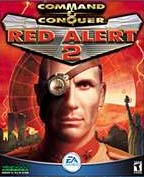  |
 COMMAND AND CONQUER: RED ALERT 2Reviewed By: Vincent LinVOLUNTEER GUEST REVIEWER
Genre: Real-Time Strategy (RTS) The Allies have won WWII, and the Americans have put Alexander Romanov as a puppeteer premier for Russia. The world is at peace - or is it? Outraged by Stalin's failure in the original game (Hitler was “removed” via a time-device, thus never rose to power), and haunted by childhood memories of Allied attacks (the Soviets/Russians were the bad guys in Red Alert 1, not the Nazis), Romanov launched a full-scale attack on the United States. The President Michael Dugan soon issues emergency military protocols, but strangely the ICBMs don't fire, the Army doesn't bulge, even the citizens of America are revolting. And so it turns out that the Soviet Union, with the help of a mind-control specialist, Yuri, has taken over the American public with their psychic abilities.
In addition to the single-player campaign mode, there is also a single-player skirmish mode, and several multiplayer modes including cooperation (where you and a friend cooperate in completing five missions), Local-Area-Network (LAN), and Internet (where you can join players from around the world by connecting to the game servers, as of now, the integrated Westwood Online (http://www.westwood.com) and GameSpy Arcade (http://www.gamespyarcade.com)). The gameplay hasn't changed that much since the original "Red Alert". The single-player missions are introduced with live-action cinematic briefings (more on this later), the economical resource is still ore and gems, and the game interface is still a radar display and “build” buttons on the right side of the screen. What Westwood Studios has changed, is that there are now four different types of units/structures - primary structures, defensive structures, infantry, and vehicles/aircraft/ships. You can train up to 30 units in each of the two latter categories, resulting in a much less-tedious way to build up your army. The game engine is a scaled down version of "Tiberian Sun", a 2D battleground consisted of “voxels” (a feature that makes the game look good, but doesn't eat up the system resources - making it available for not-so-high-end machines to run the game). There are also now three theater types - temperate, snow, and urban. The urban theater provides a need for new tactics (Allied GI or Soviet Conscripts can garrison in building, creating a “choke point” for enemies), as well as a setting for most campaign missions that allow you to fight in Chicago, Washington DC, and New York, just to name a few. Real-life monuments such as the Statue of Liberty or the White House are also included. Another improvement is the veterancy ladder, which allows normal units to advance to a veteran level, thus making their weapons, defense ability, speed, etc. stronger. There is also a “deploy” function for some of the units, such as deploying GIs to make them build sandbag walls, which increases their range and power of fire, and their armor. The Allies and Soviets have many different aspects, just like in the original game. The Allies, with the help of Dr. Einstein make extensive use of technology, such as Prism towers and Prism tanks (which uses reflected sunlight as a weapon), Spy Satellites, Spies, Aegis Cruisers, Chrono infantry (soldiers erase enemies from time) and the like. The Soviets, on the other hand, rely on mostly brutal force, for example Nuclear weapons, the heavy Apocalypse tanks, submarines, Dreadnought missile frigates, and the like. As you advance up the tech tree by building more advanced structures or using a spy to steal other technologies, more advanced weapons, units and structures become available. As mentioned above, there are briefing cinematics. These movies do not simply brief you to a mission, they also tell the story, not to mention being interesting to watch. A note of caution here though: some scenes have a sexual undertone, including an actress playing an American special-agent constantly wearing a tank top and filmed so that you could almost look down her shirt, and a scene where a Russian general (whom we later find is one of the "bad guys") is in a spa-like hot-tub playing with two bikini-clad girls (though all three are dressed). Objectional material is mainly the occultic theme of mind-control and psychic abilities, and because of the war overtone, the killing and maiming. Blood is greatly decreased. Mild profanity in the previous game “Tiberian Sun” has been totally removed (with the President saying "I wouldn't give a wooden nickel about your legacy" instead of the usual "d*mn"), and your comm. officers that brief you are very loyal. While the Allied side is generally “better”, the bad guys, or the Soviets, have various bad character models, including lust of power and sex (though barely present), treachery, betrayal, and others.Replayability is fair, with third-party maps, editors, and mods available on the 'net. With the recent release of an official map editor, the gameplay is furthur enhanced. In conclusion, this is a game that can be enjoyed by most people, a game that truly fun to play. Year of Release—2000 Positive—I personally thought this was the best C&C game made, but I am waiting for the next one, C&C Generals, to come out. This was also the least offensive one to me, because there is some blood in the others (RA, Dawn, TS) but in here, just skeletons. However, the gameplay is the best I've ever seen in a strategy game, and I plan to play it often. My Ratings: [4/5]
—Tom, age 13 Disclaimer: The opinions expressed in this Christian Spotlight review are those of the reviewer (both ratings and recommendations), and do not necessarily reflect the opinions of Films for Christ or the Christian Answers Network.
Christian Spotlight Guide2Games is part of Christian Answers. Copyright © Films for Christ. • “Christian Spotlight’s Guide to Games” and “Guide2Games” are service marks of Films for Christ.  |
